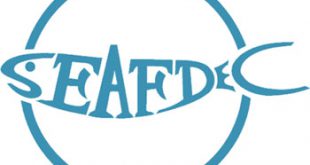Rainfall, low temperature and low salinity are WSSV risk factors
It is a brave shrimp farmer who has continued farming the tiger shrimp Penaeus monodon when most have shifted to the culture of white shrimp P. vannamei. While pond biosecurity measures have helped reduce the prevalence of the white spot syndrome virus (WSSV), death still comes to shrimp when farm conditions are not right.
What are these stressful conditions? In a study published by Ms. Eleonor Tendencia and her colleagues in the science journal Aquaculture Research (Vol. 41, 2010) after monitoring shrimp farms in Negros Island, Philippines, in 2000-2007, it seems that the stress to tiger shrimp comes from a continuous two-week rainfall which can lower atmospheric and water temperatures as well as decrease salinity. With these stresses come vulnerability to infection, and weak shrimp easily succumb to WSSV.
The researchers advised tiger shrimp farmers to closely monitor their stocks especially during periods of continuous rain.
The above is just one of the studies conducted and published by AQD on fish health management. The most recent 2010-2011 publications include:
Amar EC, Faisan JP Jr,. 2011. Efficacy of an inactivated vaccine and nutritional additives against white spot syndrome virus (WSSV) in shrimp (Penaeus monodon). The Israeli Journal of Aquaculture-Bamidgeh 63:[IIC:2011.529] 9 p
Borlongan IAG, Tibubos KR, Yunque DAT, Hurtado AQ, Critchley AT. 2011. Impact of AMPEP on the growth and occurrence of epiphytic Neosiphonia infestation on two varieties of commercially cultivated Kappaphycus alvarezii grown at different depths in the Philippines. Journal of Applied Phycology 23: 615-621
Caipang CMA, Pakingking RV Jr., Apines-Amar MJS, Huyop F, Bautista NB. 2011. Development of a polymerase chain reaction (PCR) assay targeted to the dnaJ gene of Vibrio harveyi, a bacterial pathogen in Asian seabass, Lates calcarifer. Aquaculture, Aquarium, Conservation & Legislation – International Journal of the Bioflux Society (AACL Bioflux) 4:447-454.
Cruz-Lacierda ER, Yamamoto A, Nagasawa K. 2011. Seasonal occurrence of Caligus spinosus and Parabrachiella seriolae (Copepoda) parasitic on cage-cultured yellowtail (Seriola quinqueradiata) at a fish farm in western Japan. Bulletin of the European Association of Fish Pathologists 31: 58-65 (news and views)
Erazo-Pagador G, Cruz-Lacierda ER. 2010. The morphology and life cycle of the gill monogenean (Pseudorhabdosynochus lantauensis) on orange-spotted grouper (Epinephelus coioides) cultured in the Philippines. Bulletin of European Association of Fish Pathologists 30: 55-64
Erazo-Pagador G. 2010. A parasitological survey of slipper-cupped oysters (Crassostrea iredalei, Faustino 1932) in the Philippines. Journal of Shellfish Research 29: 177-179
Hamid AAA, Hamdan S, Pakingking RV, Huyop F. 2010. Identification of Pseudomonas sp. strain S3 based on small subunit ribosomal RNA gene sequences. Biotechnology 9: 33-40
Pakingking RV Jr, Bautista NB, de Jesus-Ayson EG, Reyes O. 2010. Protective immunity against viral nervous necrosis (VNN) in brown-marbled grouper (Epinephelus fuscogutattus) following vaccination with inactivated betanodavirus. Fish and Shellfish Immunology 28: 525-533
Pakingking R Jr., Mori K, Bautista NB, De Jesus-Ayson EG, Reyes O. 2011. Susceptibility of hatchery-reared snubnose pompano Trachinotus blochii to natural betanodavirus infection and their immune responses to the inactivated causative virus. Aquaculture 311:80-86
Penaranda MMD, LaPatra SE, Kurath G. 2011. Specificity of DNA vaccines against the U and M genogroups of infectious hematopoietic necrosis virus (IHNV) in rainbow trout (Oncorhynchus mykiss). Fish & Shellfish Immunology 31: 43-51
Pedrajas-Mendoza SA, Torres JL, Amar E. 2008. Enhancing nonspecific immune response of grouper, Epinephelus coioides using levamizole as immunostimulant. University of the Philippines in the Visayas Journal of Natural Sciences 13:1-10
Sombito C, Lio-Po G, Sadaba R, Torreta R. 2009. Initial assessment of the bacterial population of Guimaras waters and soil after the Solar I Oil Spill. Philippine Journal of Natural Sciences (Oil Spill Special Issue): 15-26
Somga, JR, de la Peña LD, Suarnaba VS, Sombito CD, Paner MG, Capulos GC, Santa Maria PI, Po GL. 2010. KHV-associated mortalities in quarantined koi carp in the Philippines. Bulletin of the European Association of Fish Pathologist 30: 2-7
Tendencia EA, Bosma RH, Usero RC, Verreth JAJ. 2010. Effect of rainfall and atmospheric temperature on the prevalence of the white spot syndrome virus in pond-cultured Penaeus monodon. Aquaculture Research 41: 594-597 (short communication)
Tendencia EA, Bosma RH, Verreth JAJ. 2010. WSSV risk factors related to water physico-chemical properties and microflora in semi-intensive Penaeus monodon culture ponds in the Philippines. Aquaculture 302: 164-168
Tendencia EA, de la Peña MR. 2010. Potentials of Kappaphycus striatum (Schnitz) and Gracilaria heteroclada Zhang (Ad Xia) to control the growth of luminous bacteria Vibrio harveyi. The Philippine Agricultural Scientist 93: 109-115 (research note)
Tendencia EA, dela Peña MR. 2010. Effect of different sizes of saline red tilapia hybrid Oreochromis niloticus x O. mossambicus on the growth of luminous bacteria Vibrio harveyi. The Philippine Agricultural Scientist 93:463-467 (research note)
Tendencia EA, Verreth JAJ. 2011. Temperature fluctuations, low salinity and water microflora are risk factors for WSSV outbreaks in pond culture of Penaeus monodon. The Israeli Journal of Aquaculture-Bamidgeh 63:[IIC.63.2011.548] 7 p
Tendencia EA, Bosma RH, Verreth JAJ. 2011. White spot syndrome virus (WSSV) risk factors associated with shrimp farming practices in polyculture and monoculture farms in the Philippines. Aquaculture 311: 87-93
 SEAFDEC/AQD Southeast Asian Fisheries Development Center | Aquaculture Department
SEAFDEC/AQD Southeast Asian Fisheries Development Center | Aquaculture Department
